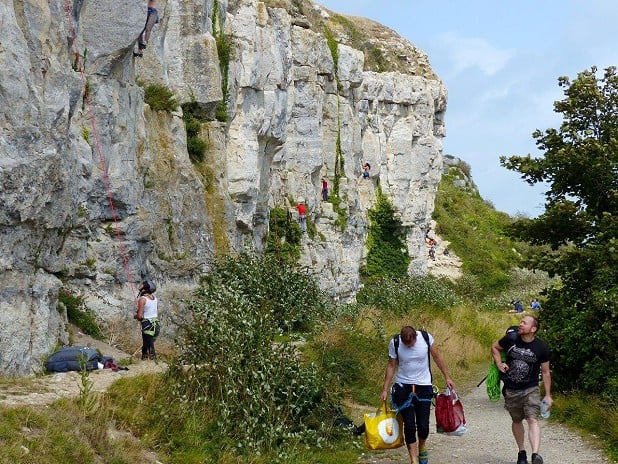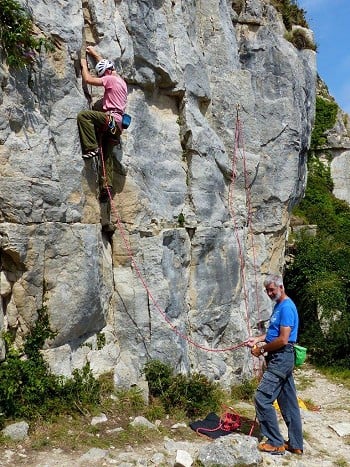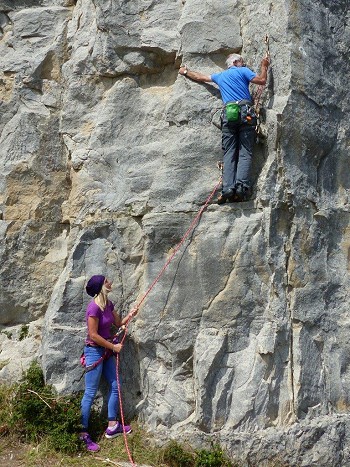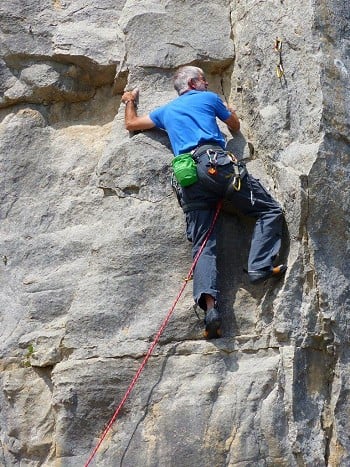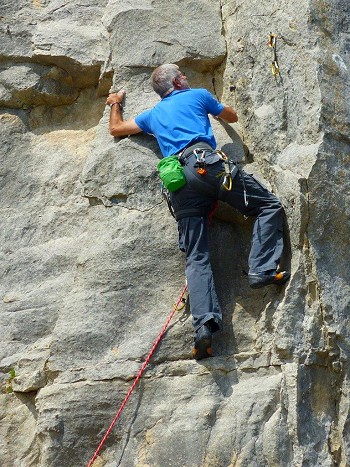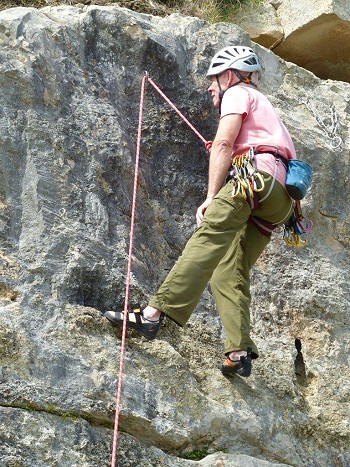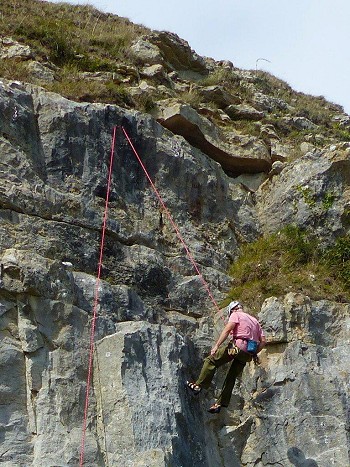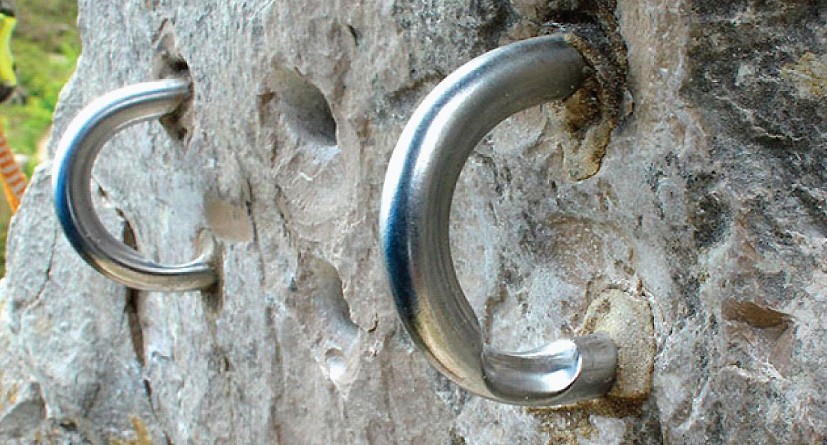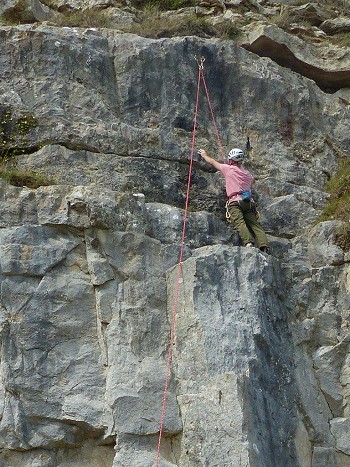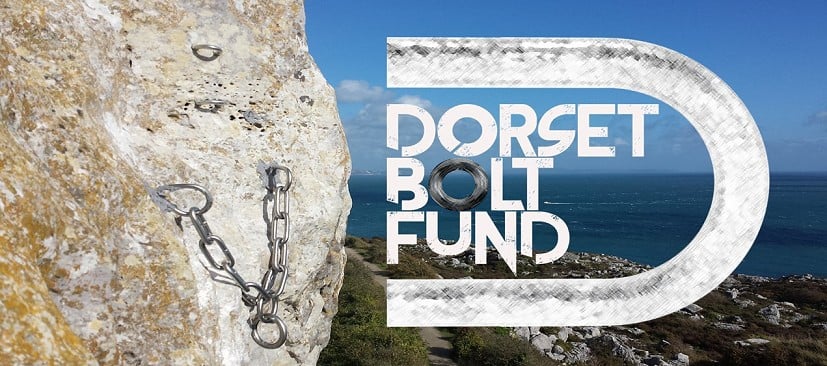10 Things to Do at a Sport Crag
Compared with Himalayan, Alpine or even trad climbing, sport climbing should be a relatively safe affair. But the very fact that it should be relatively safe means that many people don't take it as seriously as they need to. And therein lies the potential for disaster.
Back in the day, we didn't have sport crags. When routes started to have the odd bolt (e.g. Pen Trwyn, circa 1983), we heaved a collective sigh of relief and thought, "Safe!" Looking back, it seems ridiculous. It was ridiculous. Often we were trusting our lives to hand-drilled caving bolts, not in a very long way at all, using inappropriate metal for a marine environment. Ignorance is bliss!
Fast forward the best part of 40 years. Nowadays most sport climbing crags in the UK are well bolted. They should be safe environments (or as safe as it gets). But, far too often, they're not. I live less than two miles from one of the most popular sport crags in the UK. I can walk past it any day of the week and pretty much guarantee that I'll see people engaging in highly dubious practices which could have very serious consequences indeed.
Why is this? Because sport climbing feels safe. The first generation of sport climbers came from trad (and usually hill walking, before that). Trad doesn't feel safe. Ab into Red Wall on Anglesey and there's a very strong incentive indeed to pay full attention to tying into the rope and sorting out your belays.
Nowadays, of course, most climbers start indoors. Nothing wrong in that: look at Alex Honnold, Tommy Caldwell, Adam Ondra... But indoor climbing, while great for physical development, does little for psychological development. And climbing, above all else, is a mind game. Yes, climbing walls may feel like part of a narcissistic gym culture. (In the US, they're called climbing gyms – ugh!) But all climbing – yes, even indoor climbing – involves managing risk. Get this wrong and it doesn't matter how strong you are; disaster is merely a matter of time.
Now I don't want your climbing career to end up in disaster. The following suggestions may help to avoid harm. Conversely, you may scoff and mutter, "I know all this stuff!" And indeed you may well know it (though lots of people don't). But do you always practise it as you should? Does your climbing partner? Do the people next to you at the crag?
This list certainly isn't comprehensive. It's just a few basics. I'm not a climbing instructor and hold no qualifications whatsoever in climbing. In 53 years of climbing, I'll readily admit to having made horrendous mistakes. To survive for decades, somewhere along the way, you have to start learning from your mistakes – and that's what I (belatedly!) did. Of course, really smart people learn from other people's mistakes.
So, in the spirit of learning from other people's mistakes, let's imagine you go to a sport climbing crag with a mate and she's going to lead the first route. Naturally, you're a well-behaved pair, so your dog is under control, music isn't loud and you're definitely going to take your litter home with you.
1. Do a buddy check.
The first person to tell me about buddy checks was the late and much missed Mark Vallance. Back in the 1970s, Mark met Ray Jardine, the inventor of Friends. Taking a huge financial risk, he created Wild Country, to bring Friends to a mass market. The rest is history. If you own a single cam - I don't care who made it - you owe a debt to Mark.
I'm told that buddy checks come from the world of diving. For climbing, they couldn't be simpler. Before your mate leaves the ground, both of you must check that a) he or she's tied in correctly and b) you're belaying properly.
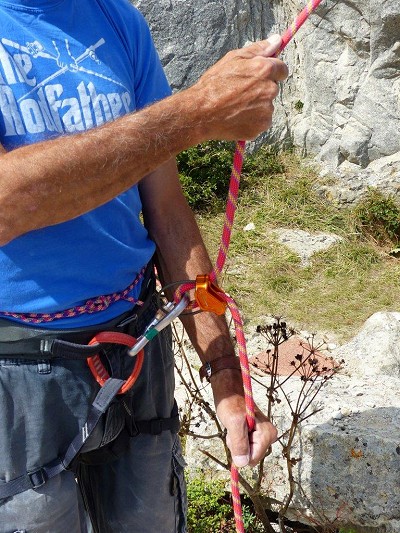
In a typical sport climbing day, you'll probably do this more than a dozen times. Throughout the year, you'll do it hundreds of times. In your climbing career, you'll do it thousands of times. Therein lies the danger! Familiarity breeds complacency. For safety, you have to get it right 100% of the time. For disaster, you only have to get it wrong once. You may be cold, hot, hungry, thirsty, hungover or simply not feeling so great. Doesn't matter! Do a slow, careful buddy check every single time. Have it hard-wired into your climbing DNA.
In the 1980s, Lynn Hill fell the entire length of the Styx wall at Buoux, through not being properly tied in. A few years ago, John Long had a bad accident indoors. (Fortunately she was relatively OK and he recovered.) If world-class climbers can get it wrong, then so can you and so can I. I'm sure that both of them would be the first to agree, "Do a buddy check – slowly and carefully – every single time."
2. Belay properly.
To my mind, the most dangerous place on most sport routes is at the anchors. If anything goes wrong here, you've got the entire length of the route to fall. The second most dangerous place is often near the ground. The problem here is that near the ground doesn't feel dangerous. Yes, we're back to our own worst enemy – complacency.
A long time ago, a wise man named Colin Mortlock made a crucial distinction between perceived risk and true risk. For most people, being near the ground has a low perceived risk. For me, until I'm clipped into something bombproof, it's got a high true risk and my soloing hat is well and truly on.
An awful lot of belayers stand far too far away from the crag. (Looks cool, huh?) If the rope goes in at a 45-degree angle, the leader may have to step around it. Not what you want – especially if the route's hard from the off. Worse, if there's a load of slack in the rope, the leader may be still facing a ground fall even after the first bolt's clipped. In my view, this is downright criminal.
Far better, in my view, to stand slightly to one side of the leader, with the rope held in against the rock, so they don't have to step around it. I'm watching that rope like a hawk until they've clipped the first two bolts. Then – and only then – I'll carefully walk out, a little distance, to watch them from a more comfortable position. I'll only use belay glasses when they're above the second bolt. So the belay specs are nudged down over my eyes when they've clipped the second bolt, on the way up and back up again when they reach it, on the way down.
If you think you're going to fall off and you can say so, then it seems only courteous to inform your belayer. Of course, a leader can pop off without any chance of saying so; a hold may snap or the route may simply be hard. So the belayer should always be alert.
When the leader reaches the anchors, there's a need for clear, unequivocal communication. However, let's imagine that your leader has reached the anchors and safely lowered without any drama. Now it's your turn.
3. Tie in safely.

Because most people feel relaxed, they chatter away to their companions, who chatter away to them, in turn. If you want to tie in safely, then shut up! If you want someone else to tie in safely, then shut up! God knows I love talking (especially at crags) but honestly it's no great imposition, even for me, to shut up for the minute or two that it takes me – or somebody else – to tie in.
Shutting up means that the prospective leader is far more likely to pay full attention to tying in. Is it worth shutting up for a minute, to safeguard someone's life? I certainly think so. In fact, there's a strong argument for people not engaging in conversation at all when they're belaying. The first priority should always be safety. The second priority should be not to annoy the person who's climbing.
Naturally, after you've tied in, you check what you've done. And then what do you do? Yes – a buddy check!
4. Start the route with clean climbing shoes.
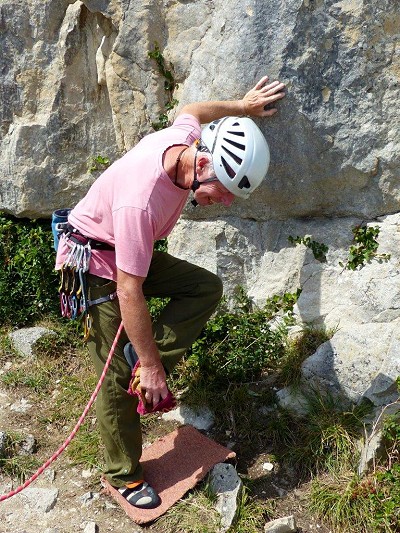
It's not rocket science – it really isn't. Either clean your shoes with your hand or (much better), carry a little piece of cloth to wipe off any dirt or moisture. Then stand on a clean rock or a little mat. Then start the route. Be considerate to others… and considerate to yourself.
And why on earth do people walk around in their climbing shoes when they're belaying or otherwise not climbing? For heaven's sake, be kind to your feet!
5. Position yourself properly.
All the time you're climbing – whether trad, sport or bouldering, outside or inside, you should be evaluating and managing risk. One obvious risk is getting the rope caught around your leg in such a position that you'll invert if you fall off. No matter how strong you are, a hold could snap unexpectedly. Any time that the rope goes around your leg, you should reposition yourself so that it isn't around your leg. If you invert and hit your head, without a helmet, it's potentially fatal.
While this is perhaps the most obvious example of being positioned improperly, in a more general sense, positioning yourself properly is about thinking through a series of 'What if's.' What if this dubious hold snaps? Where will I fall? What might I hit? Have I warned my belayer? Or, if I fall off, what's the best way of avoiding this ledge? You're probably also working out best clipping positions. You may be thinking, 'Should I go for it - or should I back off?'
Youtube is full of videos of clueless characters whose feet suddenly decide to pop (often just as they're going to clip) and would-be heroes who, pumped witless, decide to go for it nevertheless, with sadly predictable consequences.
Positioning yourself properly probably matters more in trad. But it still matters in sport. And it still matters in bouldering. Far too many people have missed the mats or fallen between them. Think through what could possibly go wrong and protect yourself, as best you can, against dire consequences.
6. Know how to thread the anchors.
So you tied in correctly, checked, did a buddy check, cleaned your shoes, were attentively belayed and positioned yourself carefully en route (phew, there's a lot to get right!) As it happened, the route went OK. Now you're at the anchors. Your mate led the route first, so now you're going to strip it of quickdraws.
Unless you're absolutely certain you know what you're doing, there's only one safe place for you – back on the ground! The words, "I'm at the anchors – what do I do?" should never, ever, ever be heard at a sport crag. And I have heard them, far too many times. Fluff things at the anchors and you could go the entire length of the route before decking. A couple of years ago, at my local crag, someone did exactly that. Amazingly he was relatively unscathed. I would have expected a ground fall from even half the height he went to be highly injurious, if not downright fatal.
There are lots of ways to secure yourself to the anchors. It's up to you which one you use. You may use different methods for different circumstances. What matters is that you have 100% confidence in your chosen method 100% of the time.
Please note – I said 'secure yourself to the anchors'. It's becoming frighteningly common to see people securing themselves to only one anchor – often because they've only got one length of sling attached to their harness. Sorry – the tail's wagging the dog. Route equippers have put in two bolts/staples for a very specific purpose. The second bolt isn't there by accident; it's there by design. You need to be secured to both. You also need to be sure that you can't drop the rope.
This time round, you can't do a buddy check. No buddy at the anchors. And you're at the most dangerous part of the route. So you need to check your ropework, very, very carefully indeed.
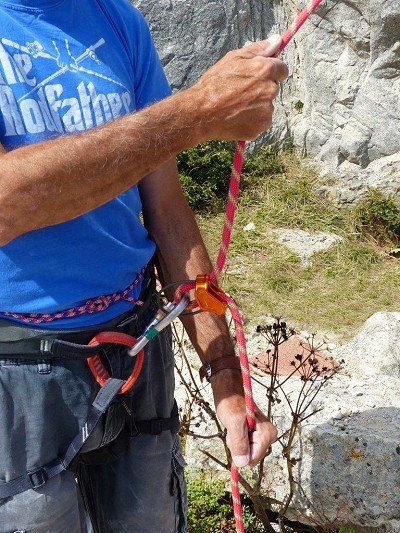
Whatever system you use, it needs to be as simple as possible. If there are lots of slings, quickdraws or lengths of rope around the anchors, the setup is getting dangerously complex and you're liable to get mixed up and make a (fatal?) mistake.
Often, when people struggle up a route, when they arrive at the anchors, relief and adrenaline set in and they go into rush mode. Why on earth rush? Why put your life in peril just to save a couple of minutes? What was it Mae West said, "I like a man who takes his time…"
Lastly – and very importantly – I don't care how long the leader takes at the belay. The belayer should remain in full control of the rope at all times. Recently a mate went climbing with someone who reckoned he could just wander off while the aforesaid mate was at the anchors. Not so!
7. Top-rope through quickdraws, not the anchors.
Let's imagine you've done your route and someone wants to top-rope it. On Portland, most bolts are glued in staples because this seems to be a better option for a marine environment. It's becoming increasingly common for people to top-rope through the top staples, i.e. the anchors. Worse, sometimes people top-rope through just one!
It seems ridiculous that ropes could wear away stainless steel. And they don't. But bits of tiny grit in ropes being pulled against the steel will wear it away, in time. And that time may only be a few years. On Portland, quite a few staples have been badly eroded in this manner. On inland crags, where the lower-offs will probably be chains and rings or karabiners, again they can be worn away. Sometimes the culprits are climbing instructors who've threaded the rope through the anchors for convenience. Such laziness is both deeply unprofessional and absolutely unacceptable.
Equipping the route took somebody time, effort and cost. Respect their time, effort and cost. If you – or someone in your party – is going to top-rope, then do it through quickdraws, not directly into staples or in situ krabs. If you've got to go back up at the end of the day to strip the route – well then, so be it.
8. Top-rope with the last quickdraw clipped.
Why do we top-rope? Because it feels safe. Maybe we want to work a route and adjust body positions in fine detail. Maybe we don't feel confident and just want to enjoy a route with no 'leading stress'. The reasons don't really matter. We can pretty much do as we want, provided we don't damage the route and we're scrupulously honest afterwards.
Top-roping feels safe. But is it always safe? Remember Colin Mortlock and his perceived risk versus true risk. What if something which seems very safe could turn out to be very risky indeed? What if top-roping a route could turn out to be much more dangerous than leading it?
Let's take a couple of scenarios. In the first, someone leads a route with eight bolts/staples, clips another two on the anchors and lowers. As they lower, they're clipped into 10 bolts/staples. This is pretty much as safe as things get.
Imagine someone else top-ropes the route. If the rope is clipped into all the bolts and the person doesn't unclip them then, at the anchors, they're also clipped into 10.
However, top-roping like this, the rope will tend to be in the way. Another option is to pull the rope through and top-rope from the other end, unclipping from each quickdraw in turn. This means that the rope isn't in the way. Conversely, it tends to be awkward (unclipping is usually harder than clipping). At the beginning, the person is also into 10 bolts/staples. But then they're into nine. Then eight. And so on…
If they unclip the last quickdraw before the anchors, they're now into just two (or maybe even one, if the leader didn't clip both anchors?) If anything goes wrong here (e.g. they fluff threading the anchors), they can fall the entire length of the route.
However if, when they reach the last quickdraw before the anchors, they unclip it from the rope going from them to the anchors and re-clip it to the rope going from the anchors to the belayer, then, as long as they're still attached to the rope, even if (heaven forbid) something dreadful happens at the anchors, there's still a piece of protection between them and the ground.
Worth doing? Worth taking a couple of seconds to change the quickdraw over from one rope to another?? Surely it can't do any harm – and, one day, it might just save your life.
Years ago, I stumbled across this by accident. (I'm sure many other people have also discovered it.) Because I do it regularly, climbing partners have picked it up from me. And others have picked it up from them. I think it's well worth doing.
9. Know how to retreat.
Let's imagine you're leading and, for whatever reason, you don't want to finish the route. Maybe it's hard, or you lack confidence, or your presence is needed urgently on the ground. You could stick clip to the anchors. In principle, this is probably the safest option, as long as you're 100% confident in your ability to stick clip safely. If you're not 100% confident to stick clip your way up a route, don't attempt it! If you're going to stick clip up a route, in addition to being able to use the stick clip competently, you must be 100% sure of your ropework and your communication with your belayer.
An alternative is to clip your rope through a karabiner on a bolt and lower. Obviously, if you strip the lower quickdraws, you will become more and more reliant on that bolt and krab. So you must be confident of both.
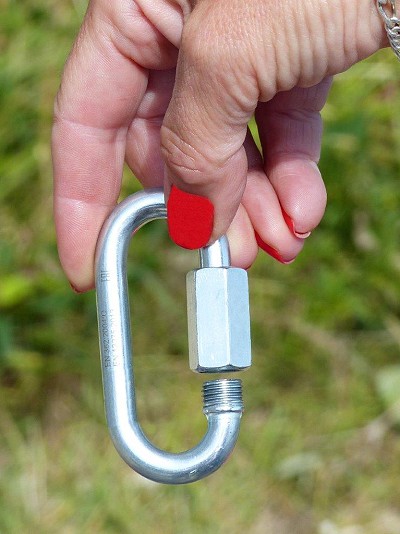
Increasingly people are using maillons on routes at Portland. Please don't use maillons on any sea cliffs! On Portland, it's entirely unnecessary. Threading a single staple is - or should be - simplicity itself. (As ever, make sure that staple is sound.) An extra maillon – or a krab - on the staple is just something else to go wrong. And, crucially, unless it's made of marine grade stainless steel (and most aren't), in a marine environment it will rust and lock tight, in no time at all! Then there are only two ways to remove it. One is to use a portable angle grinder. Not many of those around! The other way is to hacksaw it off. A mate did this on a popular Portland route, The Accelerator. It took him several hours of bloody hard work to remedy a mistake which conversely took just a couple of minutes for some thoughtless person to make. Krabs will also rust. Once, on Portland, I stripped a route of quickdraws which had been there for a year. Some of the krabs had to be crowbarred open with every ounce of strength I possessed.
If you have to retreat, make it as safe as possible for yourself - and have consideration for people climbing the route after you.
10. Support the bolt fund.
You've survived a day at the crag. Congratulations! Maybe there's a bit more to think about than you imagined. Well… ignorance may be bliss. But it isn't necessarily safe. And the best mistakes are the ones you learn from but don't actually make yourself.
Sport crags - what can we say about sport crags? Well, the most obvious observation is that they're bolted. People you've probably never met and probably never will meet made your visit possible by virtue of their unselfish time, effort and cost. If you've benefited from their efforts, then why not do a little to pay back? Crags need constant maintenance. Neglected trad crags vanish into the vegetation, no matter how popular they once were. Sport routes can get dirty if they don't see much traffic. The minute a bolt is placed, it starts to degrade. Sooner or later, it will need to be replaced.
We can all give back. It may be helping to clean a route, whether trad or sport (sport routes, if neglected, can get dirty/overgrown too). It may be a donation to a bolt fund. Better still, it might be a monthly standing order to a bolt fund. Would you really miss £5 a month? Unlikely. But that £5 would be £60 a year and £600 in ten years. It all adds up.
Rebolting is a skilled task and typically bolt fund groups have a shortage of skilled helpers. If you've time, maybe you could come along and help out. In the beginning, it might just be fetching and carrying. If you're going to rebolt, then you'll have to learn a wide variety of techniques. Someone will need to dedicate time and effort to teach you. Don't do as some have and cynically rip off their time and effort just to get another tick on your CV.
The bottom line is this: we can all give back, in one way or another – or maybe a combination of ways. Making crags safer benefits us today and will benefit others tomorrow. So please help to do it.
A Few Final Thoughts.
There are probably three types of people who are most at risk of getting things wrong at a sport crag: people who just don't know what to do (which is fair enough; we were all here once), people who are being told what to do by others who don't know what to do and people who should know better but are still being sloppy. The first two types of people are probably transitioning from walls to outside, the third type is probably old trad climbers who aren't taking sport climbing as seriously as they should.
Obviously trad is more complicated than sport. But safe sport procedures must be ingrained in you. If you think you need help, seek out highly recommended people, whether professional or amateur. And I don't care how long you've been climbing; if you think you need help, for heaven's sake, get it!
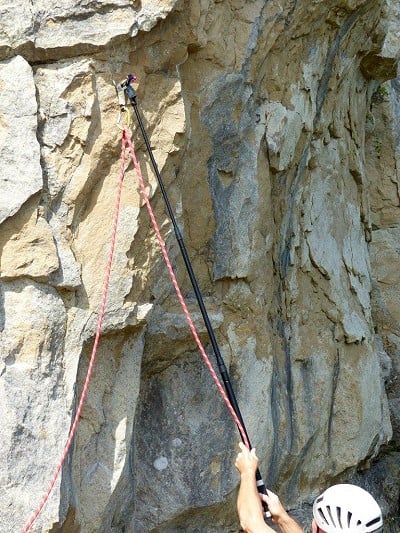
A while ago, some people I know got a fearful telling-off from some guy at the crag. They were top-roping a micro-route of mine, Pop For the Top, through the staples. OK, it was bad practice but somebody going ballistic really isn't the best approach. It spoiled their day; one of the women was really upset about it. So, if you're going to make a helpful suggestion (or two), please be diplomatic. Most people are reasonable and will take heed of friendly advice. Conversely, nobody's perfect. I make mistakes; we all make mistakes. Every day of our lives is a struggle with our fallibility, a struggle to do better.
I'll leave you with the wisest words ever written about climbing. The author paid a terrible price for his wisdom. If you take heed of what he says, you'll be doing yourself a huge favour. Nearly 150 years later, these words are as valid as on the day they were first written:
'Climb if you will, but remember that courage and strength are nought without prudence, and that a momentary negligence may destroy the happiness of a lifetime. Do nothing in haste; look well to each step; and from the beginning think what may be the end.' Edward Whymper, 1871
With special thanks to Marti Hallett, Rob Kennard, John Leonard, Adam Perrett and Sarah Perrett.
